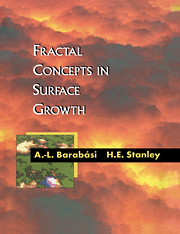Book contents
- Frontmatter
- Contents
- Preface
- Notation guide
- PART 1 Introduction
- PART 2 Nonequilibrium roughening
- PART 3 Interfaces in random media
- PART 4 Molecular beam epitaxy
- 12 Basic phenomena of MBE
- 13 Linear theory of MBE
- 14 Nonlinear theory for MBE
- 15 Discrete models for MBE
- 16 MBE experiments
- 17 Submonolayer deposition
- 18 The roughening transition
- 19 Nonlocal growth models
- 20 Diffusion bias
- PART 5 Noise
- PART 6 Advanced topics
- PART 7 Finale
- APPENDIX A Numerical recipes
- APPENDIX B Dynamic renormalization group
- APPENDIX C Hamiltonian description
- Bibliography
- Index
18 - The roughening transition
Published online by Cambridge University Press: 23 December 2009
- Frontmatter
- Contents
- Preface
- Notation guide
- PART 1 Introduction
- PART 2 Nonequilibrium roughening
- PART 3 Interfaces in random media
- PART 4 Molecular beam epitaxy
- 12 Basic phenomena of MBE
- 13 Linear theory of MBE
- 14 Nonlinear theory for MBE
- 15 Discrete models for MBE
- 16 MBE experiments
- 17 Submonolayer deposition
- 18 The roughening transition
- 19 Nonlocal growth models
- 20 Diffusion bias
- PART 5 Noise
- PART 6 Advanced topics
- PART 7 Finale
- APPENDIX A Numerical recipes
- APPENDIX B Dynamic renormalization group
- APPENDIX C Hamiltonian description
- Bibliography
- Index
Summary
The primary focus of this book is on interface roughening generated by various nonequilibrium deposition processes. However, crystal surfaces may be rough even under equilibrium conditions – with no atom deposition. Consider, e.g., a flat surface in equilibrium at a very low temperature. Thermal fluctuations do not have an observable effect on the shape of the crystal, and all atoms remain in their appropriate lattice positions. As temperature increases, the probability that an atom will break its bonds with its neighbors increases. Some atoms hop onto neighboring sites, thereby generating roughness on the atomic scale. At first glance, one might expect a gradual transition to a rough morphology, since the higher the temperature, the more the atoms wander on the surface – until the surface melts. Indeed this is a correct description of the short-ranged correlations between neighboring atoms. However, as we shall see, on much longer length scales there is a distinct (higher order) thermodynamic phase transition that takes place at a critical temperature TR. For T < TR the crystal is smooth, corresponding to a flat facet, while for T > TR it is rough, implying a rounded crystal shape analogous to a liquid drop. This ‘roughening transition’ can be successfully described using ideas of statistical mechanics, the formalism being analogous to that developed in previous chapters.
Equilibrium fluctuations
The lowest energy state of the crystal corresponds to a flat surface.
- Type
- Chapter
- Information
- Fractal Concepts in Surface Growth , pp. 192 - 208Publisher: Cambridge University PressPrint publication year: 1995

